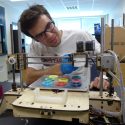UW-Madison students set trends in information technology
Students continue to embrace technologies for personal use, including, more than ever, in the classroom. Well-versed before entering college, university students use a variety of new technologies to help them with their coursework.
These findings are part of the 2009 Student Computing Survey, conducted last spring by the University of Wisconsin–Madison’s Division of Information Technology. The purpose of the annual survey is to monitor trends in information technology, gauge usage of UW–Madison’s technology products and services, and to gather feedback on ways to improve those products and services.
Laptop ownership continues to grow among students to 93 percent, while desktop ownership declined to 26 percent. Ownership of handheld Web devices (smart phone, iPhone, Blackberry, Treo, iPod Touch) is also on the rise, at 24 percent.
Seventy-three percent of students use the Windows (Vista or earlier version) operating system. Thirty-three percent reported using Mac OS (X or earlier version), an increase from 28 percent in 2008.
Regarding the technology UW–Madison provides its students, 91 percent are satisfied or very satisfied. Students are most satisfied with the campus wireless network in public locations, campus computer kiosks, general access computer labs, My UW–Madison Web portal and WiscMail e-mail.
Students rely on the latest technologies for schoolwork and everyday use.
For schoolwork, they use wikis (45 percent), Gmail (42 percent), Google Docs tools such as Writely and spreadsheets (39 percent), and YouTube (31 percent). Most students use text-messaging (83 percent), mp3 players (81 percent), social networks (80 percent), flash drives (78 percent) and digital cameras (73 percent) on a daily basis.
Students report a desire to receive training that either enhances existing skills or widens their knowledge. They particularly seek classes in graphics and animation (53 percent), spreadsheets (48 percent), Web design (44 percent), hardware (36 percent) and e-portfolio development (32 percent).
Regarding the safekeeping of personal data and other sensitive data, 52 percent rarely or never back up important data, 65 percent update or patch their computer software regularly, 51 percent install UW–Madison’s Security Starter Software, and 67 percent know how to identify safe Web sites.
Other findings from the 2009 Student Computing Survey:
- Eighty-three percent of students report being aware of the issue of illegally downloading music and movies (copyright infringement) on campus, and 74 percent are aware of the penalties for downloading material illegally. Sixty-one percent are aware that music files may be shared inadvertently by the installation of file-sharing programs such as LimeWire.
- Eighty-nine percent of respondents have taken a course that used Learn@UW, UW–Madison’s course-management software. Seventy-nine percent of those who have used Learn@UW describe their experience as positive or very positive.
- When asked “What new or improved information technology service or resource would you like at UW–Madison?” top responses included better computer labs, more kiosks and faster wireless; more student discounts/free services, such as classes, printing, training, hardware, audio books and online textbooks; and more disc space/file storage on WiscMail and My WebSpace.
In February, a random sample of 1,200 UW–Madison students was selected from all undergraduate, graduate, professional and special students. The students were contacted via e-mail and invited to participate in this Web survey. Of those invited to participate, 374 responded, resulting in a response rate of 31 percent.

